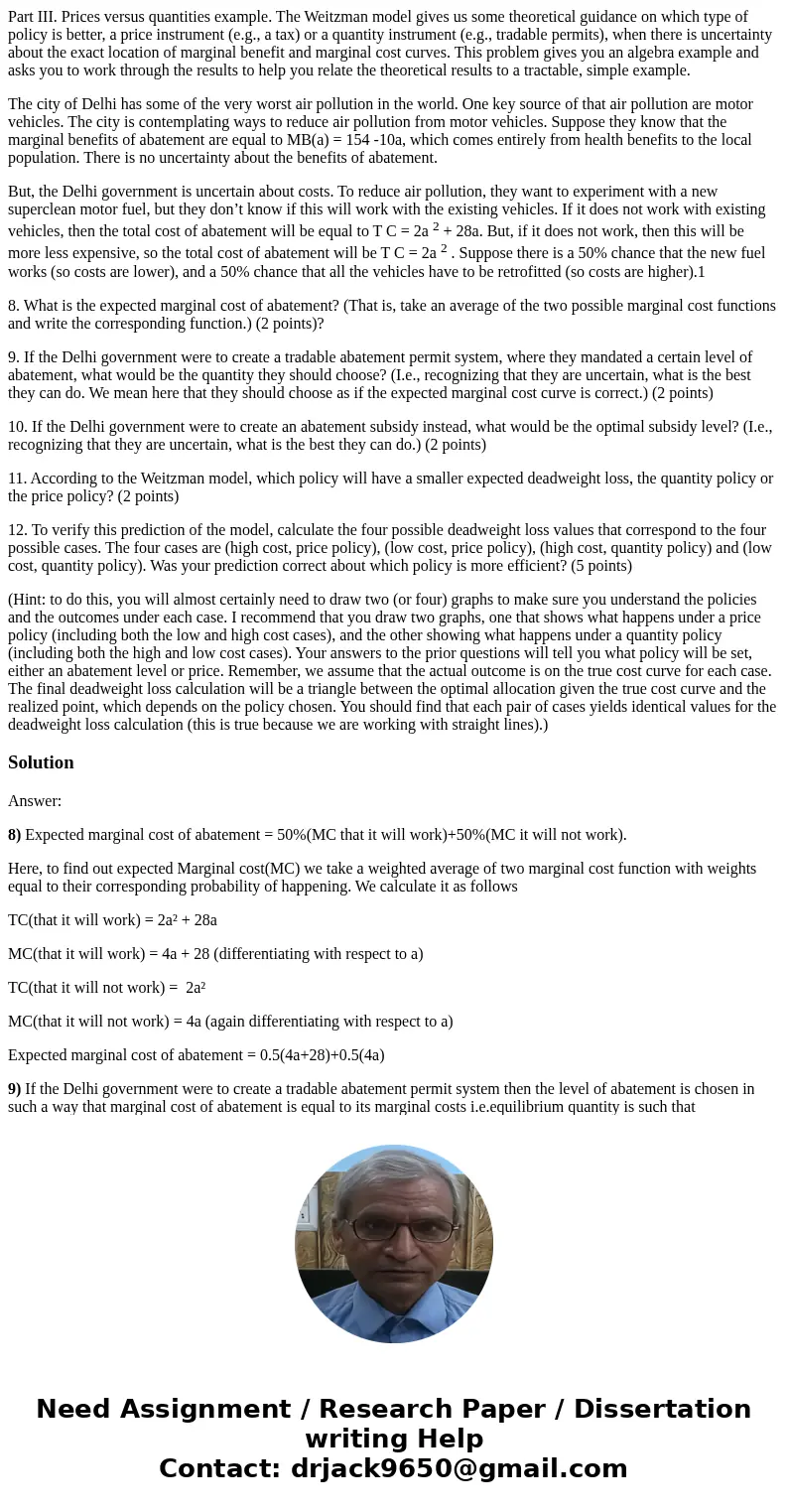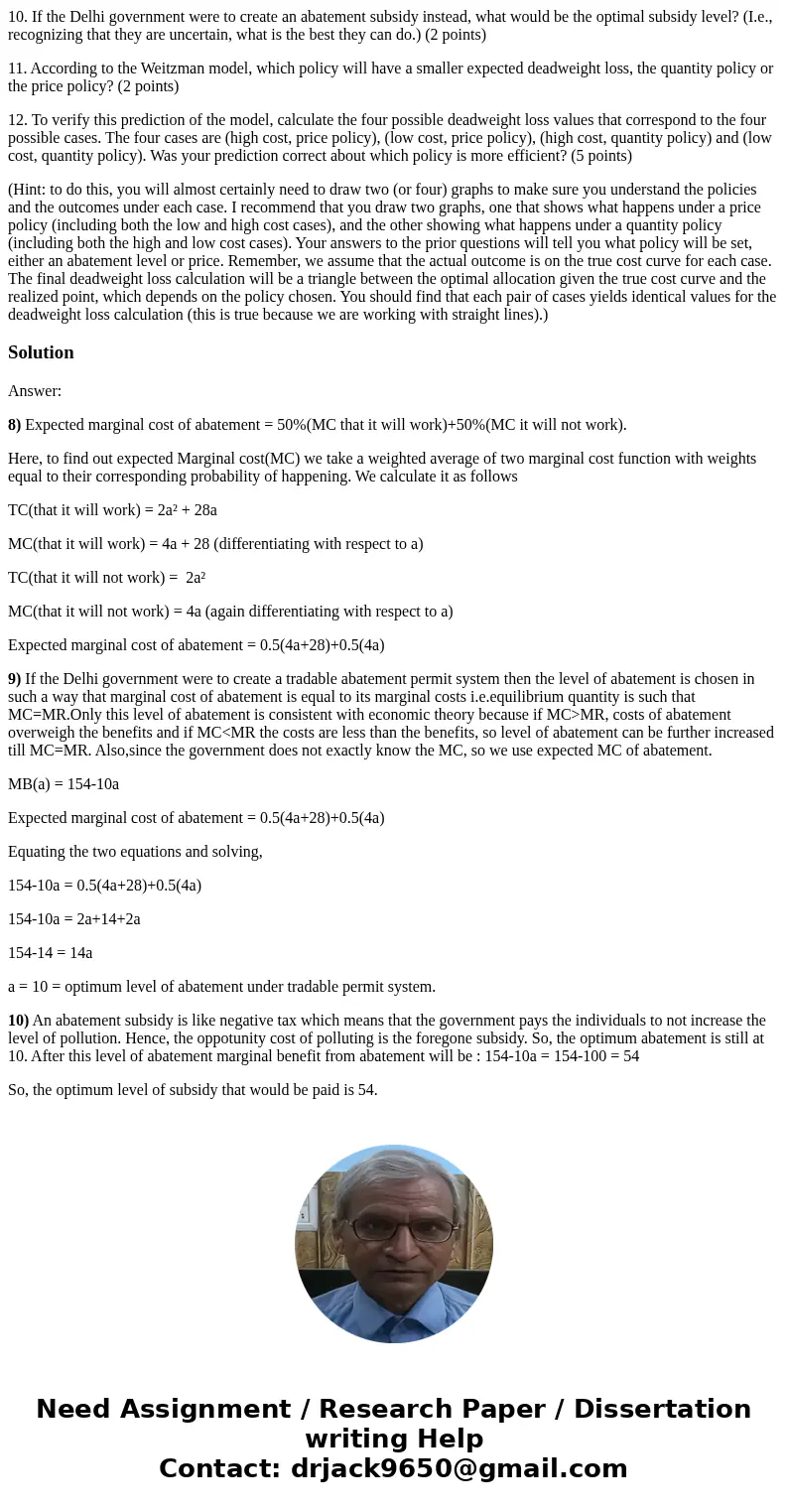Part III Prices versus quantities example The Weitzman model
Part III. Prices versus quantities example. The Weitzman model gives us some theoretical guidance on which type of policy is better, a price instrument (e.g., a tax) or a quantity instrument (e.g., tradable permits), when there is uncertainty about the exact location of marginal benefit and marginal cost curves. This problem gives you an algebra example and asks you to work through the results to help you relate the theoretical results to a tractable, simple example.
The city of Delhi has some of the very worst air pollution in the world. One key source of that air pollution are motor vehicles. The city is contemplating ways to reduce air pollution from motor vehicles. Suppose they know that the marginal benefits of abatement are equal to MB(a) = 154 -10a, which comes entirely from health benefits to the local population. There is no uncertainty about the benefits of abatement.
But, the Delhi government is uncertain about costs. To reduce air pollution, they want to experiment with a new superclean motor fuel, but they don’t know if this will work with the existing vehicles. If it does not work with existing vehicles, then the total cost of abatement will be equal to T C = 2a 2 + 28a. But, if it does not work, then this will be more less expensive, so the total cost of abatement will be T C = 2a 2 . Suppose there is a 50% chance that the new fuel works (so costs are lower), and a 50% chance that all the vehicles have to be retrofitted (so costs are higher).1
8. What is the expected marginal cost of abatement? (That is, take an average of the two possible marginal cost functions and write the corresponding function.) (2 points)?
9. If the Delhi government were to create a tradable abatement permit system, where they mandated a certain level of abatement, what would be the quantity they should choose? (I.e., recognizing that they are uncertain, what is the best they can do. We mean here that they should choose as if the expected marginal cost curve is correct.) (2 points)
10. If the Delhi government were to create an abatement subsidy instead, what would be the optimal subsidy level? (I.e., recognizing that they are uncertain, what is the best they can do.) (2 points)
11. According to the Weitzman model, which policy will have a smaller expected deadweight loss, the quantity policy or the price policy? (2 points)
12. To verify this prediction of the model, calculate the four possible deadweight loss values that correspond to the four possible cases. The four cases are (high cost, price policy), (low cost, price policy), (high cost, quantity policy) and (low cost, quantity policy). Was your prediction correct about which policy is more efficient? (5 points)
(Hint: to do this, you will almost certainly need to draw two (or four) graphs to make sure you understand the policies and the outcomes under each case. I recommend that you draw two graphs, one that shows what happens under a price policy (including both the low and high cost cases), and the other showing what happens under a quantity policy (including both the high and low cost cases). Your answers to the prior questions will tell you what policy will be set, either an abatement level or price. Remember, we assume that the actual outcome is on the true cost curve for each case. The final deadweight loss calculation will be a triangle between the optimal allocation given the true cost curve and the realized point, which depends on the policy chosen. You should find that each pair of cases yields identical values for the deadweight loss calculation (this is true because we are working with straight lines).)
Solution
Answer:
8) Expected marginal cost of abatement = 50%(MC that it will work)+50%(MC it will not work).
Here, to find out expected Marginal cost(MC) we take a weighted average of two marginal cost function with weights equal to their corresponding probability of happening. We calculate it as follows
TC(that it will work) = 2a² + 28a
MC(that it will work) = 4a + 28 (differentiating with respect to a)
TC(that it will not work) = 2a²
MC(that it will not work) = 4a (again differentiating with respect to a)
Expected marginal cost of abatement = 0.5(4a+28)+0.5(4a)
9) If the Delhi government were to create a tradable abatement permit system then the level of abatement is chosen in such a way that marginal cost of abatement is equal to its marginal costs i.e.equilibrium quantity is such that MC=MR.Only this level of abatement is consistent with economic theory because if MC>MR, costs of abatement overweigh the benefits and if MC<MR the costs are less than the benefits, so level of abatement can be further increased till MC=MR. Also,since the government does not exactly know the MC, so we use expected MC of abatement.
MB(a) = 154-10a
Expected marginal cost of abatement = 0.5(4a+28)+0.5(4a)
Equating the two equations and solving,
154-10a = 0.5(4a+28)+0.5(4a)
154-10a = 2a+14+2a
154-14 = 14a
a = 10 = optimum level of abatement under tradable permit system.
10) An abatement subsidy is like negative tax which means that the government pays the individuals to not increase the level of pollution. Hence, the oppotunity cost of polluting is the foregone subsidy. So, the optimum abatement is still at 10. After this level of abatement marginal benefit from abatement will be : 154-10a = 154-100 = 54
So, the optimum level of subsidy that would be paid is 54.


 Homework Sourse
Homework Sourse